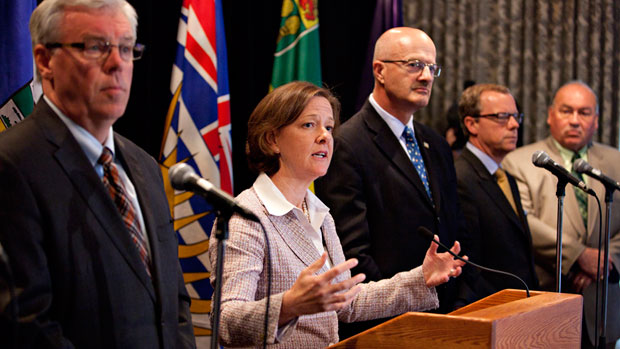Over the past year and a half, each of the Prairie provinces held crucial elections resulting in decisive majority governments. These governments will shape the political and cultural direction of the Prairies for the next four years – and, potentially, for a decade or more. As such, this series will examine the leaders we have chosen for this monumental task, who they are and where they plan to take us.
Over the past several months, I’ve been re-watching (in chronological order) that ever-entertaining mob series that put HBO on the proverbial map—The Sopranos.
With its examination of the immense moral ambiguities of life, the series begins (at least in the mind of the viewer) to take on the variegated complexity generally reserved for great American literature. In short, it asks the big questions.
In one such instance of what amounts to pop-philosophizing, Tony Soprano is stuck in a long-term comma and begins to dream that he is another man, in a strange city, with Alzheimer’s, and everyone he encounters believes he is someone else entirely.
This crisis of identity causes the bullish New Jersey mafia boss to wake up briefly in his hospital bed, asking himself, desperately and urgently: Who am I? Where am I going?
Over the past three installments of this modest series on Prairie premiers, and the exertion of Prairie power, I’ve barely articulated this kind of existential dilemma in a political context. But what I’ve come to realize is that, despite our apparent decisiveness in bestowing majority mandates to three quite different political parties (in three quite different provinces), we are less sure of ourselves on the national stage.
[related_content slugs=”assessing-prairie-power-part-three-brad-walls-fortress-saskatchewan,assessing-prairie-power-part-two-greg-selingers-do-nothing-manitoba,assessing-prairie-power-part-one-alison-redford-and-the-fracturing-of-alberta-conservatism” description=”More of Prairie Power series” position=”right”]
We are, in some ways, questioning our role in Canada.
The ideological power of the Alberta Fire Wall is over, and voters rebuked a variation of that doctrine when they turned away from the Wildrose Alliance in last year’s election. Saskatchewan’s NDP dynasty, which for decades shaped major national public policy debates, now stands as a bad joke next to Brad Wall’s fortified 49-seat stronghold in the province. And Manitoba’s Greg Selinger, though he acts as the figurehead of a mighty Dipper machine, exerts little influence on the national stage due to a comparatively weak economic performance.
Prairie politics have shifted. And many are now asking, just like Tony Soprano: Who am I? Where am I going?
The trend that runs through the first three installments of this series is the relative success of political parties who embrace a coalition model (what the federal Liberals call the “big tent”), and the policy failures of those who do not.
Manitoba is an example of where the coalition model has failed. The provincial New Democrats may lack ideological purity (former NDP premier Gary Doer is a top diplomat for a Conservative government) but they are certainly vastly at odds with the Progressive Conservatives and Manitoba Liberals. Some have blamed the split in that free market-oriented vote for the vast foothold the party retains in the province.
The ongoing electoral success of the Dippers has ultimately led to gargantuan public policy failures. But in Saskatchewan, where political pragmatism dominates the political debate, the province has experienced unprecedented economic prosperity.
The Prairies can bring these lessons to bear on the national stage, if only its citizens—particularly engaged, young intellectuals—muster up the will to do it.
I have two friends from Manitoba who recently moved to Ottawa and are working for Conservative parliamentarians. My friends are partisan, but only in the sense that the Conservative Party of Canada best aligns with their particular worldview. Like most rational people, they maintain a variety of educated opinions that are arrived at on an issue-by-issue basis.
The bizarre tribalistic rhetoric employed by many Conservatives (as well as those who sit on the opposition benches) is nowhere in their vocabulary.
My two pals comprise the future of the Conservative Party of Canada. And they know the party’s future, for two guys from Manitoba, is a bright one.
The federal Tories currently hold 51 of the 56 seats available on the Prairies. In time for the next election, there will be six more seats in Alberta to account for urban population growth, meaning 62 House of Commons seats will be up for grabs in the three prairie provinces. Right now, those are solidly blue.
That is a political market to rival Quebec, and it is significantly more than the seat total for British Columbia.
Much has been written about the fact Stephen Harper built a winning electoral coalition without substantial Quebec representation. Unlike any prime minister in Canadian history who needed Quebec for a majority, Harper presides over an alliance between the Prairies and Ontario, with some decent support in B.C.
Alberta, Saskatchewan and Manitoba are crucial constituencies for this government, and this political party. So why, when we generally seek consensus politics provincially, do we tolerate the dogmatic and unaccountable elements of the federal Tories we elected? Why don’t we define the Saskatchewan Party model, even the Alison Redford model, as good governance and demand the Conservatives live up to that definition?
Their future as the Government of Canada in many ways depends on us.
In short, and in answer to our existential dilemma, the Prairies can play an integral role in re-shaping—from the inside—the culture of Parliament Hill. With people like my two friends at the helm, the prairies can help bring good governance to the national stage.
___
Ethan Cabel writes for the Spectator Tribune.
Follow us on Twitter: @SpectatorTrib
